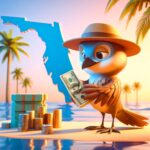Have you been dreaming of spending the winter months basking in warm sunshine, but you’re worried about the costs? I’ll help you learn the tips and tricks for how to be a snowbird on a budget.

Don’t worry, with some planning and budgeting, snowbirding can be an accessible lifestyle option! I’ve created this comprehensive guide that shares insider tips to make your seasonal migration more affordable.
As a snowbird, you escape cold northern winters by heading to warmer southern climates for a portion of the year. Also known as sunseekers or sun-chasers, snowbirds flock to popular southern states, typically from November through April.
While the snowbird lifestyle involves travel and sometimes maintaining two homes, you can take steps to reduce expenses. Follow my guide to help keep costs low while enjoying the snowbird experience to the fullest.
Research Top Snowbird Destinations
The first step is choosing an affordable winter destination. Consider these factors when researching top snowbird spots:
- Warm weather – Look for average winter temps in the 60s and 70s. Steer clear of areas prone to winter storms or cold snaps
- Low cost of living – Favor regions with affordable housing and general living costs. Watch state income and property taxes
- Outdoor activities – Snowbirds embrace an active lifestyle. Nearby beaches, hiking trails and parks are ideal
- Amenities – Seek communities with recreation centers, clubs, entertainment and healthcare
Based on the criteria above, here are some of the most popular and affordable snowbird states:
- Florida – A prime snowbird destination, especially southwest Gulf Coast regions like Tampa and Naples. Learn more in my in-depth guide on the Cheapest Places For Snowbirds in Florida
- Texas – Warm weather and low taxes lure snowbirds to the Rio Grande Valley and Central Texas. I’ve put together a list of the Cheapest Places For Snowbirds in Texas to further narrow the search
- Arizona – Retirement communities cluster around Phoenix and Tucson. Lake Havasu City also attracts snowbirds. Check out my guide on the Cheapest Places for Snowbirds in Arizona for more info!
- California – Budget snowbird options exist away from the coast in areas like Palm Springs. Learn more about the Cheapest Places for Snowbirds in California
- South Carolina – Golf haven Myrtle Beach and coastal Charleston areas attract northerners. My list of the Cheapest Places for Snowbirds in South Carolina can help you explore more options
- Alabama – The warm Gulf Shores region is an emerging snowbird hotspot
Popular summer destinations like Myrtle Beach are surprisingly affordable in what is considered the “off season” for beach-going. However, it’s still perfect for those looking to escape the cold northern weather.
Lesser-known spots near major snowbird havens can also provide budget value. Small towns on the outskirts offer lower costs for housing and living.
Do your homework when choosing an optimal winter escape for your snowbirding lifestyle and budget.
Calculate Your Snowbird Budget
Crunching numbers is key to pulling off snowbirding, especially when you’re on a fixed income. Develop a realistic budget covering all expected snowbird living expenses, including:
- Housing – Rent or mortgage payments on your winter residence (whether it’s a temporary short term or a permanent residence)
- Food – Groceries, dining out, snacks and entertainment
- Transportation – Gas, maintenance and insurance for your vehicle. This also includes travel costs from your Northern location when you do head south
- Healthcare – Insurance premiums, prescriptions, copays and procedures
- Utilities – Electricity, water, cable TV, Internet and phone service
- Entertainment – Activities, shows, classes and hobbies
Track your current monthly expenditures in each category. This provides insight into how spending might translate to snowbird life.
Next, research costs for your planned snowbird destination using online tools. Compare housing listings, grocery prices and gas costs. Use tourism sites for details on entertainment options and fees.
Factor in any impacts to healthcare costs and insurance. Understand tax implications for state income and property taxes.
From your analysis, establish a monthly snowbird budget with a buffer for unexpected expenses. Having an emergency savings cushion prevents budget-breaking surprises.

Remember that something like food is needed regardless of location, so you might not see a big increase here. However, you’ll need to leave the heat on at home to prevent your pipes from freezing, so you may need to double up on utilities for both locations.
You could probably turn the cable off while you’re gone, though to save some money there. Just make sure to factor in the costs of both locations to get the best understanding of overall expenses.
If your dream snowbird lifestyle exceeds fixed retirement income, explore ways to supplement. For example, rental income from your primary home up north can offset snowbirding costs. Alternatively, some snowbirds take part-time jobs at their winter destination for extra cash.
Optimize Travel and Housing Expenses
Housing and travel represent two major snowbirding costs. Minimize both through smart planning:
Lodging
- Opt for a small home, condo or mobile home for the most affordable options. Large luxury homes have higher rents and bills
- Drive or rent an RV and stay in a campground for a lower cost option. Check out programs like RVShare or Outdoorsy for rental options to help plan costs, and I have a helpful guide on the Best Snowbird Florida RV Campgrounds as well as other states to help you choose the right park for you!
- Seek longer-term rentals for the full snowbird season. Short vacation stays have premium pricing
- Consider resident-only mobile home parks open just to winter visitors for budget rates
- Shared housing through services like Airbnb or VRBO helps cut individual costs
Travel
- Drive to your snowbird destination since flying multiple people plus luggage gets expensive
- Bring just essentials and buy food, toiletries and even clothing at local shops
- Consolidate gear as much as possible – laptop, tablet, e-reader and phone can all merge into one device
- Leave off-season and extra belongings in a rented storage unit rather than toting everything
- Forward mail to your winter address and go paperless wherever possible to avoid delivery hassles. Learn more about How Snowbirds Handle Mail in my guide!
With some creative problem solving, snowbirds can reduce the expenses associated with temporary living arrangements.
Save on Everyday Snowbird Living
Once settled into your winter oasis, use these tips to trim costs on routine snowbird living expenses:
- Grocery shop like a local by embracing fresh in-season produce. Seek out discounts and loyalty programs at regional chains
- Cook more meals at home. Limit dining out to social occasions or special treats. Don’t treat this like a vacation, but rather go about your daily life in a different location
- Take advantage of abundant free activities like beaches, hiking, parks and sightseeing. Museums and attractions often have discount days
- Bring hobby gear and do activities you love that don’t require expensive equipment or fees – reading, photography, yoga, birdwatching
- Enjoy entertainment at no cost by attending free concerts, classes, and community events
- Use coupons, cash-back apps and loyalty programs to save on everyday basics
With a little creativity, snowbirds can enjoy rich experiences on a limited budget!
Have the Right Snowbird Insurance
Don’t jeopardize your nest egg through lack of proper insurance:

Health Insurance
- Make sure your plan allows out-of-state coverage to provide consistent care.
- Ask about prescription refills and telehealth options to reduce gaps during travel.
- Locate nearby in-network healthcare partners ahead of time for your winter destination to avoid surprise fees in an emergency.
- Learn more about Health Insurance For Snowbirds in my in-depth guide!
Home Insurance
- Update your policy to cover a vacant home while you are away snowbirding.
- Make sure liability and disaster coverage remains adequate.
Auto Insurance
- If you aren’t bringing your car with you, suspend your auto insurance policy if allowable by state regulations, or switch to minimum coverage to reduce the premiums while you’re not using it
- Inquire with your auto insurance carrier about insuring in a different state for the period of time you are there, as your premiums may drop based on state averages or lower minimum requirements
- Review discounts for low mileage driven and anti-theft devices as well
Protecting your health, home and car provides peace of mind so you can relax and enjoy your snowbird adventures.
Make Your Northern Home Snowbird-Friendly
To maximize savings as a snowbird, optimize your permanent residence:
- Downsize to reduce taxes, heating costs and maintenance. Sell the big empty nest and buy a comfortable condo or smaller home
- Rent it out fully furnished to earn extra income while you are away. Vet tenants carefully
- Install smart home technology like smart thermostats and automated lighting. Control it all remotely to save power
- Hire a yard service for mowing, raking, plowing and upkeep while you are gone
Your Northern home can become either a money saver or money maker with some preparation before migrating south.
Work Options for Snowbirds
Some industrious snowbirds subsidize their winter getaways by working part-time. This generates extra income while providing social engagement.
Common snowbird jobs include:
- Seasonal retail associates at shops, grocery stores and malls
- Tourism, food service and hospitality roles at hotels, restaurants and attractions
- Rideshare or delivery drivers to earn cash cruising around beautiful scenery. Sign up with a company such as Uber to get started
- Dog walkers, house sitters or pet care assistants for others that are traveling short term
- Freelance gigs like writing, social media management, tutoring or consulting using digital skills
More entrepreneurial snowbirds turn their hobbies and passions into paid gigs:
- Offer music or dance lessons
- Sell handmade crafts, jewelry or artwork at local fairs
- Teach classes on topics like cooking, health and photography
- Lead tours highlighting regional sights, history or nature spots
With a little creativity, snowbirds can profit from their passions while enjoying warm winter weather.
Frequently Asked Questions
How much does it cost to be a snowbird?
Snowbirding costs vary widely based on destination, lodging options, and lifestyle. Budget snowbirds can spend about $2,000 per month per person covering basic living expenses.
Luxury snowbird life can cost upwards of $7,000 per month all-inclusive. Focus your destination research on affordable areas to keep expenses in check.
What are the best snowbird states for affordability?
Great budget snowbird picks include Texas (Rio Grande Valley), Florida (central Gulf coast), Arizona (smaller towns around Phoenix), and Alabama (Gulf Shores). These regions offer warm weather plus low housing and living costs.
Some even have special planned communities for visiting snowbirds.
Should I rent or buy a snowbird home?
Renting provides more flexibility to change locations year-to-year. Buying has tax advantages but locks you into one winter destination.
Try renting your first few seasons to find the optimal snowbird spot before committing to a purchase.
How can I earn extra money as a snowbird?
Popular snowbird side jobs include retail, hospitality, and transportation gigs that take advantage of the influx of seasonal tourists.
Snowbirds also earn cash transforming hobbies into lessons or small businesses. Renting your permanent home up north can offset snowbirding costs too.
Final Thoughts: Get Ready for Affordable Seasonal Fun
Snowbirding provides the chance to enjoy the best of both worlds – escaping harsh northern winters for sunny southern relaxation, without breaking the bank.
Follow the budgeting, planning and cost-saving tips in this guide to make seasonal migration possible. Spend winter days immersed in comfortable warmth basking in your favorite activities.
The snowbird lifestyle awaits. With strategic preparation, you can enjoy this seasonal roaming on a budget. Take the first step and let the affordable adventures begin.
- How to Be a Snowbird on a Budget: Don’t Break the Bank! - April 2, 2024
- How Do Snowbirds Afford Two Homes? A Complete Guide - March 28, 2024
- 15 Best Mexican Restaurants in Tucson Arizona - January 15, 2024




